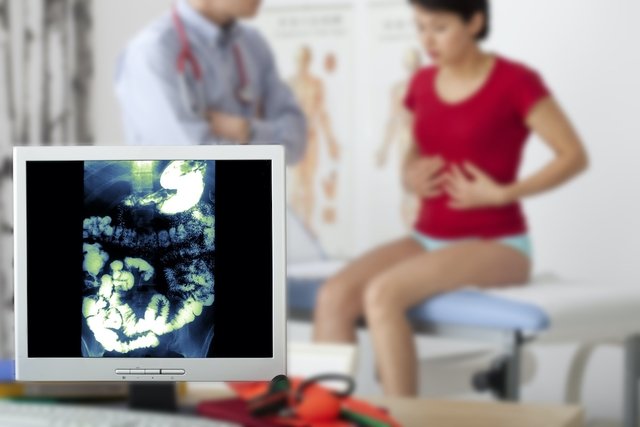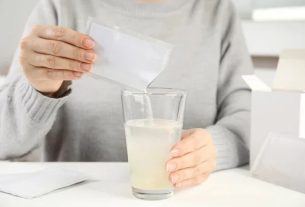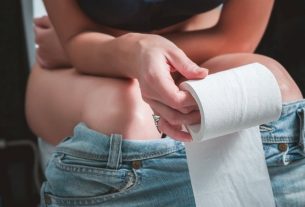Green diarrhea usually happens when feces pass through the intestine too quickly, reducing the rate of water absorption. This is common when consuming excessive dark green vegetables, coffee or spicy foods, for example, as these are foods with a laxative effect.
However, green diarrhea can also be a sign of more serious health problems such as intestinal infection, irritable bowel syndrome or Crohn’s disease, which often cause other symptoms such as excess gas, abdominal bloating, fever or loss of appetite. .
Treatment for green diarrhea depends on the cause of this condition and may include drinking fluids and probiotics. Therefore, if diarrhea takes more than 2 days to disappear or if symptoms such as abdominal pain, nausea or vomiting appear, it is advisable to consult a gastroenterologist to identify the cause and indicate the most appropriate treatment.
What could your green diarrhea be?
To find out what could be causing your green diarrhea, please answer the following questions:
This tool should only be used to try to identify the possible cause of green diarrhea and should not replace consultation with the doctor, who is responsible for confirming the diagnosis and recommending the most appropriate treatment.
7 main causes of green diarrhea
The main causes of green diarrhea are:
1. Eat lots of dark green vegetables
Dark green vegetables such as broccoli, kale, chard, arugula or spinach are rich in fiber that promotes bowel movements and generally helps to relieve constipation or diarrhea. However, when consumed in excess, they can make the stool softer or more liquid, and cause diarrhea, which is green in color due to the high concentration of chlorophyll, the pigment that gives the leaves their color.
What to do: Diarrhea generally improves within a day or two after reducing consumption of these foods, and is not a cause for concern. However, it is important to keep the body well hydrated, and if the diarrhea does not improve, you should consult your general practitioner to assess your health status and check if there are any other problems that could be causing the green diarrhea.
2. Consuming coffee, alcohol or spicy foods
Excessive consumption of coffee, alcohol or spicy foods, such as chili peppers or jalapeños, for example, can speed up digestion, having a laxative effect, which makes the stool more liquid, causing diarrhea. Additionally, bile does not have time to turn brown, turning the stool green.
What to do: These foods should be consumed in moderation, in small quantities, so as not to cause a laxative effect and allow the bile to have the expected action in the intestine, without interfering with the color of the feces and causing green diarrhea.
3. Use iron supplements
The use of oral supplements containing iron in their composition, for the treatment of anemia, can change the color of the stool, causing it to appear darker, which means that the body is absorbing the iron correctly.
However, when the iron in oral supplements is not completely absorbed by the intestine, dark green or black diarrhea may appear as a side effect.
What to do: It is recommended to consult a doctor to evaluate the treatment and, if necessary, switch to another form of iron supplementation, such as intravenous use, carried out in a hospital. Find out how anemia is treated with intravenous iron.
4. Using laxatives
The use of laxatives increases bowel movements, reducing the absorption of water by the intestine, which ends up making the stool more liquid and causing diarrhea.
The green color is caused by the presence of undigested bile. Bile is a brownish-green liquid, produced in the liver, whose function is to digest fat from food, and gradually changes color to brown as it progresses through the intestine.
Thus, excessive or prolonged use of laxatives, in addition to making the stool more liquid, does not allow the bile to change color, causing watery diarrhea.
What to do: the use of the laxative must be stopped and, normally, the feces return to their normal color within 2 to 3 days. However, if there is no improvement or symptoms such as severe abdominal cramps, nausea, vomiting, stomach pain or the presence of blood in the stool appear, you should consult a doctor or go to the hospital.
5. Intestinal infections
Green diarrhea can also be caused by infections caused by Salmonella sp or by Giardia lamblia. The infection by Salmonella spis a bacterial infection of the intestines normally caused by contaminated food and green diarrhea is one of the main symptoms, and may also be accompanied by other symptoms such as nausea and vomiting, abdominal pain, fever, blood in the stool, headache and muscle pain.
Giardiasis is a disease caused by a parasite called Giardia lamblia, which is transmitted through ingestion of contaminated water. In addition to green liquid diarrhea, other symptoms may appear such as gas, abdominal pain and bloating, fever, nausea and vomiting, loss of appetite or dehydration.
What to do: It is important, in both cases, to drink plenty of fluids to maintain hydration, as a lot of water is lost through diarrhea. However, if symptoms do not improve, you should consult a general practitioner or gastroenterologist, who may recommend the use of antibiotics.
6. Using antibiotics
The use of antibiotics, such as cephalosporins or penicillins, can disturb the balance of bacteria that live in the intestine and participate in the digestion of nutrients. This interferes with the absorption of nutrients and water by the intestine, leaving stools soft or liquid.
Furthermore, the good bacteria in the intestine are responsible for processing bile, which, when unchanged, due to a lack of bacteria, does not change color, causing a green color.
What to do: It is important not to interrupt antibiotic treatment without the doctor’s knowledge, so you should contact your doctor and report the presence of diarrhea. During treatment, you must keep your body hydrated, drinking at least 8 glasses of water per day. Additionally, the use of some probiotics can help regulate intestinal bacteria and improve green diarrhea. Check out more about probiotics.
7. Irritable bowel or Crohn’s disease
People with Crohn’s disease, irritable bowel syndrome or ulcerative colitis may also have green diarrhea, due to poor fat digestion and inflammation of the intestinal mucosa, associated with other symptoms such as abdominal pain or excess gas.
Furthermore, people who have had their gallbladder removed may also have green diarrhea, because as the bile produced in the liver is not stored in the gallbladder, it passes into the intestine, thus giving the feces a green color.
What to do: You must undergo the treatment recommended by the gastroenterologist, in addition to following an adequate diet in accordance with the guidance of a nutritionist, and thus avoid worsening diarrhea or worsening symptoms.
Which doctor to consult
The best doctor to consult in case of green stools is a gastroenterologist, who will identify the correct cause and initiate the most appropriate treatment.
Make an appointment with the gastroenterologist in the region closest to you, to identify the cause of your green diarrhea:
Green diarrhea in pregnancy
Green diarrhea during pregnancy occurs mainly due to the use of prenatal vitamin supplements, prescribed by the obstetrician, containing iron in its composition, and is generally not a cause for concern. It is important that pregnant women continue taking vitamins in the doses recommended by their doctor and drink at least 8 glasses of water per day.
However, if green diarrhea does not improve within 3 days, or is accompanied by fever, nausea, vomiting, back pain, pain on the right side of the abdomen, cramps or bloating, you should seek immediate medical attention or the nearest emergency room. next.
What can green stools in babies be?
In the first two to three days after birth, it is normal for the baby to have soft, sticky, greenish-black stools, which is meconium, the baby’s first stool that contains substances that were released into the baby’s intestines during pregnancy.
After three to five days, the baby’s feces go through a transition phase, due to breastfeeding, turning brown around the sixth day.
For babies fed infant formulas, green stools may continue for longer, probably due to the iron present in the formula. However, this color may also be due to an infection, change in milk, intolerance to a food, presence of bile, ingestion of greenish fruits or vegetables or even due to the use of medicines. See what the color of your baby’s stool means.
When to go to the doctor
It is important to seek medical help if green diarrhea lasts more than 3 days or is accompanied by symptoms such as:
- Nausea or vomiting;
- Dor abdominal;
- Fever;
- Blood in the stool;
- Presence of mucus in feces.
In addition, immediate medical attention or the nearest emergency room should be sought if the person presents symptoms of dehydration such as dark urine, dry or sticky mouth, excessive tiredness, dizziness, headache, mental confusion or fainting.

Sign up for our newsletter and stay up to date with exclusive news
that can transform your routine!
Warning: Undefined array key "title" in /home/storelat/public_html/wp-content/plugins/link-whisper-premium/templates/frontend/related-posts.php on line 12
Warning: Undefined array key "title_tag" in /home/storelat/public_html/wp-content/plugins/link-whisper-premium/templates/frontend/related-posts.php on line 13




